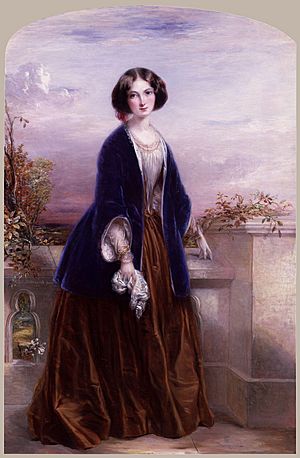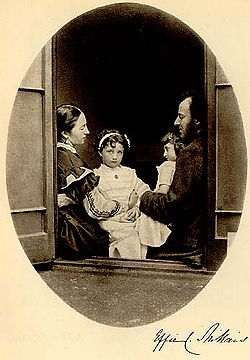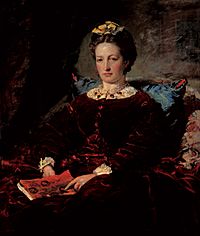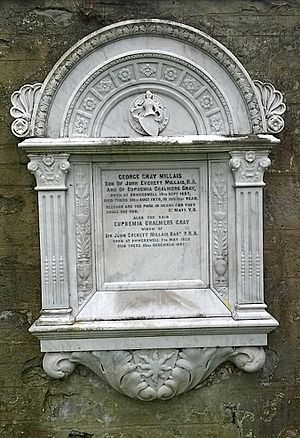Effie Gray facts for kids
Quick facts for kids
Effie Gray
|
|
|---|---|

Gray portrait, 1851 (she thought the portrait made her look like "a graceful doll")
|
|
| Born | Euphemia Chalmers Gray 7 May 1828 Perth, Perthshire, Scotland |
| Died | 23 December 1897 (aged 69) Perth, Perthshire, Scotland |
| Occupation | Author, artist |
| Period | Victorian era |
| Spouse | |
| Children | 8, including John Guille Millais |
| Relatives | Sophie Gray (younger sister) |
Effie Gray (born Euphemia Chalmers Gray; 7 May 1828 – 23 December 1897) was a Scottish artist's model. She became the wife of the famous Pre-Raphaelite painter John Everett Millais. Before this, she was married to the art critic John Ruskin. However, their marriage was ended legally, which caused a public stir in Victorian times. This interesting story has been told in many plays, movies, and even an opera.
Contents
Effie Gray's Early Life
Effie Gray was born on 7 May 1828 in Perth, Scotland. Her parents were George Gray, a lawyer, and Sophia Margaret. She grew up in a lovely house called Bowerswell. As a child, her family called her "Phemy," but she later became known as "Effie."
Effie had two younger sisters, Sophie and Alice. Both of them often posed for paintings by John Everett Millais. From 1842 to 1844, Effie went to Avonbank school in England. Her parents wanted her to lose her Scottish accent there. Effie was a very good student and won many prizes. She left school early to help her mother after some of her siblings sadly passed away from scarlet fever.
Effie's First Marriage to John Ruskin
When Effie was 12, and John Ruskin was 21, he wrote a fantasy story for her called The King of the Golden River. Effie's family knew Ruskin's father. They hoped Effie and John would marry when she was older.
After some time, Effie married John Ruskin on 10 April 1848. She was 19 years old. For their honeymoon, they traveled to Venice, Italy. Ruskin was there to research his book, The Stones of Venice. While in Scotland, they lived at Bowerswell, Effie's family home. This house had also been home to Ruskin's grandparents.
Effie and Ruskin had very different interests. Effie enjoyed meeting new people in Venice. Ruskin, however, preferred to study alone. He spent his time drawing old buildings like the Ca' d'Oro and the Doge's Palace. He worried these buildings might be destroyed by soldiers.
Effie's Relationship with John Everett Millais
While still married to Ruskin, Effie posed for a painting by John Everett Millais. The painting was called The Order of Release. It showed her as a loyal wife helping her husband.
Later, Millais went with Effie and Ruskin on a trip to Scotland. He was painting a portrait of Ruskin. During this trip, Effie and Millais became very close. They fell in love while staying in the Trossachs area. Millais drew many sketches of Effie while working on Ruskin's portrait. He also sent funny cartoons of himself, Effie, and Ruskin to his friends.
After they returned to London, Effie left Ruskin. She sent back her wedding ring and said she wanted to end their marriage. With her family's help, she pursued the case. This caused a big public discussion. Their marriage was legally ended in 1854.
Marriage to John Everett Millais

In 1855, Effie married John Millais. They had eight children together. Their youngest son, John Guille Millais, became a well-known artist who drew birds.
Effie also modeled for many of her husband's paintings. One famous painting is Peace Concluded (1856). In this artwork, she is shown as a symbol of beauty. In 1885, her husband was given a special title by Queen Victoria. He became Sir John Everett Millais, a Baronet. Because of this, Effie became known as Lady Millais.
Millais' Art and Family Life
Effie was very good at helping manage Millais' art career. She often worked with him to choose what he would paint. Her own writings show how much she admired his art. Even after they married, his paintings kept the detailed style of the Pre-Raphaelite artists for several years.
However, Millais eventually changed his style. He stopped focusing so much on tiny details. He began to paint in a looser way. This allowed him to create more paintings. Many of his later works were inspired by his family life with Effie. He often used their children and grandchildren as models.
Later Life and Legacy
Effie Gray was introduced to Queen Victoria in 1850. However, because her first marriage was ended, she was not allowed to attend events where the Queen was present. This affected her social standing. Many people in society still supported her, though.
Eventually, when Millais was very ill, the Queen changed her mind. This happened because of her daughter, Princess Louise. The Queen allowed Effie to attend an official event.
Effie Gray passed away at Bowerswell on 23 December 1897. This was 16 months after her husband, John Millais, died. She is buried next to her son George in Kinnoull Parish Church churchyard in Perth. This churchyard is shown in Millais' painting The Vale of Rest. Effie's father had given a special window to Kinnoull Church in 1870. It was based on designs drawn by Millais.
Effie Gray in Stories and Films
The story of Effie Gray's marriages has been told many times in plays, movies, and books:
- The Love of John Ruskin (1912), a silent movie.
- The Love School (1975), a BBC TV series.
- John Ruskin's Wife (1979), a novel.
- Dear Countess (1983), a radio play.
- The Passion of John Ruskin (1994), a short film.
- Modern Painters (1995), an opera.
- The Countess (1995), a play.
- The Order of Release (1998), a radio play.
- The Woman Who Gave Birth to Rabbits (2002), a collection of short stories.
- Mrs Ruskin (2003), a play.
- Desperate Romantics (2009), a BBC TV drama series.
- Effie Gray (2014), a film starring Dakota Fanning.




